2012 RENAULT FLUENCE dashboard
[x] Cancel search: dashboardPage 27 of 241
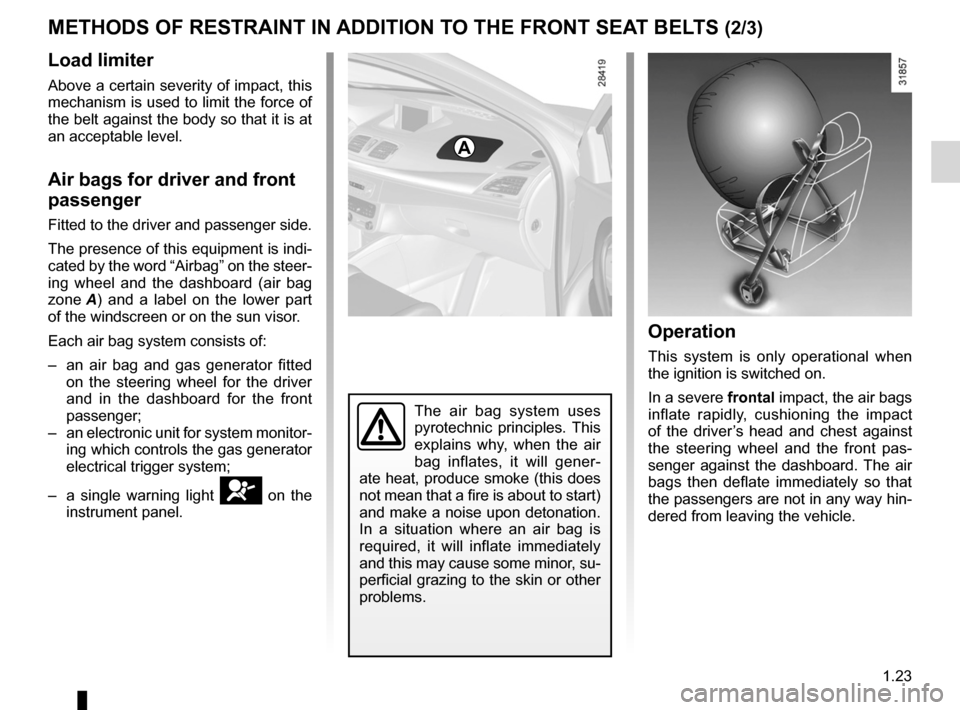
JauneNoirNoir texte
1.23
ENG_UD21620_3
Dispositifs complémentaires aux ceintures avant (L38 - X38 - Renault\
)
ENG_NU_891_892-7_L38-B32_Renault_1
METhODs OF REsTRAINT IN ADDITION TO ThE FRONT sEAT BELTs (2/3)
Load limiter
Above a certain severity of impact, this
mechanism is used to limit the force of
the belt against the body so that it is at
an acceptable level.
Air bags for driver and front
passenger
Fitted to the driver and passenger side.
The presence of this equipment is indi -
cated by the word “Airbag” on the steer-
ing wheel and the dashboard (air bag
zone A ) and a label on the lower part
of the windscreen or on the sun visor.
Each air bag system consists of:
– an air bag and gas generator fitted
on the steering wheel for the driver
and in the dashboard for the front
passenger;
– an electronic unit for system monitor-
ing which controls the gas generator
electrical trigger system;
– a single warning light
å on the
instrument panel.
Operation
This system is only operational when
the ignition is switched on.
In a severe frontal impact, the air bags
inflate rapidly, cushioning the impact
of the driver’s head and chest against
the steering wheel and the front pas -
senger against the dashboard. The air
bags then deflate immediately so that
the passengers are not in any way hin-
dered from leaving the vehicle.
A
The air bag system uses
pyrotechnic principles. This
explains why, when the air
bag inflates, it will gener -
ate heat, produce smoke (this does
not mean that a fire is about to start)
and make a noise upon detonation.
In a situation where an air bag is
required, it will inflate immediately
and this may cause some minor, su-
perficial grazing to the skin or other
problems.
Page 28 of 241
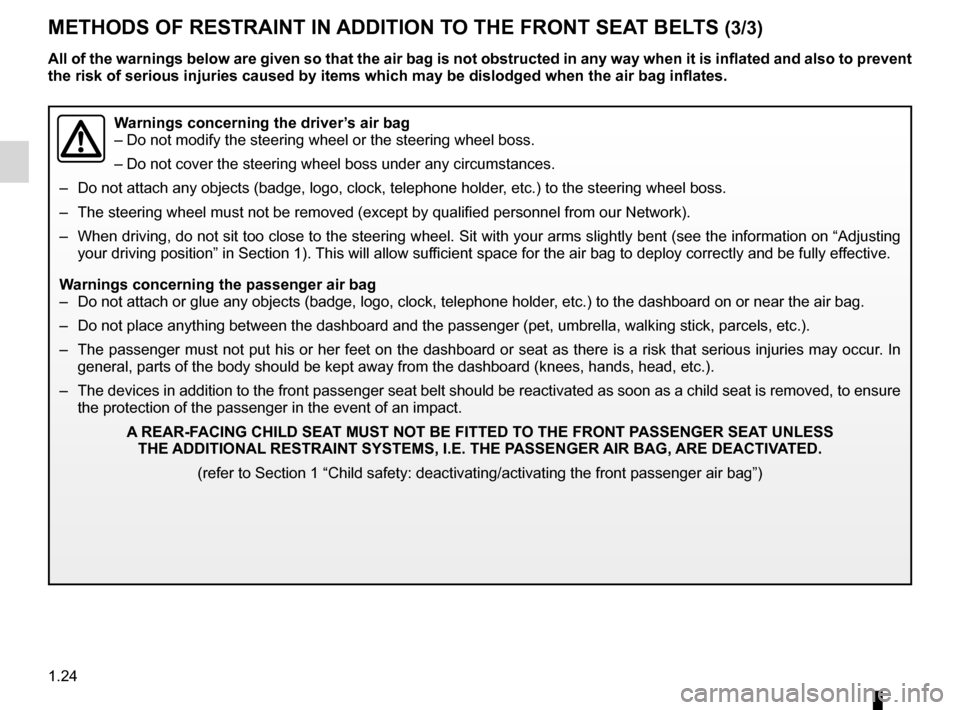
1.24
ENG_UD21620_3
Dispositifs complémentaires aux ceintures avant (L38 - X38 - Renault\
)
ENG_NU_891_892-7_L38-B32_Renault_1
METhODs OF REsTRAINT IN ADDITION TO ThE FRONT sEAT BELTs (3/3)
Warnings concerning the driver’s air bag
– Do not modify the steering wheel or the steering wheel boss.
– Do not cover the steering wheel boss under any circumstances.
– Do not attach any objects (badge, logo, clock, telephone holder, etc.) to the steering wheel boss.
– The steering wheel must not be removed (except by qualified personnel from our Network).
– When driving, do not sit too close to the steering wheel. Sit with your arms slightly bent (see the information on “Adjusting
your driving position” in Section 1). This will allow sufficient space for the air bag to deploy correctly and be fully effective.
Warnings concerning the passenger air bag
– Do not attach or glue any objects (badge, logo, clock, telephone holder, etc.) to the dashboard on or near the air bag.
– Do not place anything between the dashboard and the passenger (pet, umbrella, walking stick, parcels, etc.).
– The passenger must not put his or her feet on the dashboard or seat as there is a risk that serious injuries may occur. In
general, parts of the body should be kept away from the dashboard (knee\
s, hands, head, etc.).
– The devices in addition to the front passenger seat belt should be reactivated as soon as a child seat is removed, to ensure
the protection of the passenger in the event of an impact.
A REAR-FACINg ChILD sEAT MUsT NOT BE FITTED TO ThE FRONT p AssENgER sEAT UNLEss
ThE ADDITIONAL REsTRAINT sYsTEMs, I.E. ThE p AssENgER AIR BAg, ARE DEACTIVATED.
(refer to Section 1 “Child safety: deactivating/activating the front\
passenger air bag”)
All of the warnings below are given so that the air bag is not obstructed in any way when it is inflated and also to prevent
the risk of serious injuries caused by items which may be dislodged when\
the air bag inflates.
Page 47 of 241
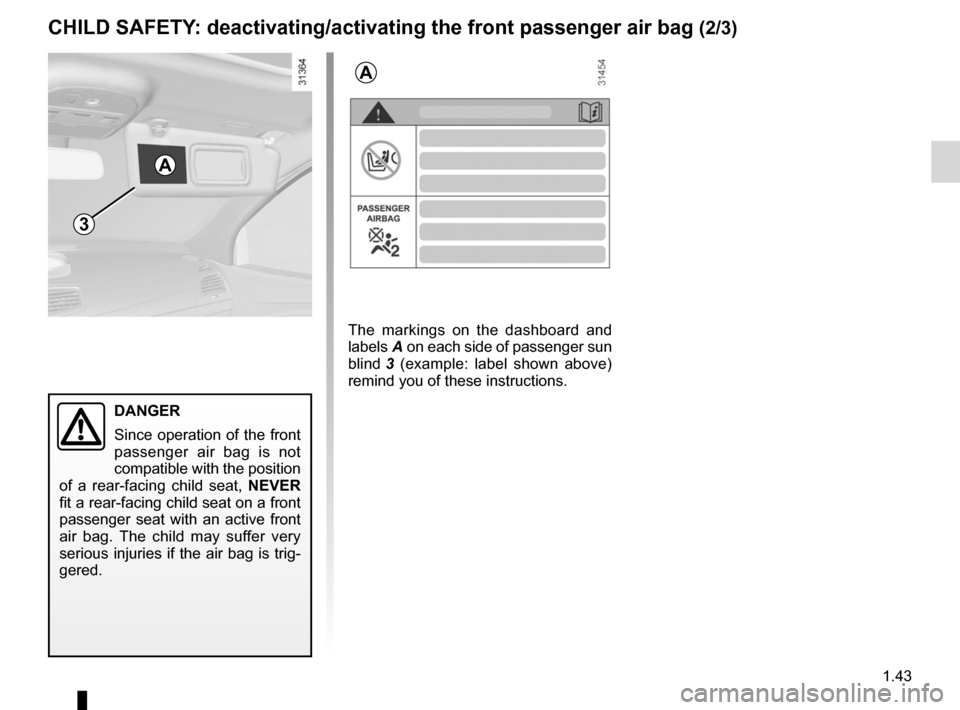
JauneNoirNoir texte
1.43
ENG_UD17911_3
Sécurité enfants : désactivation/activation airbag passager ava\
nt (L38 - X38 - Renault)
ENG_NU_891_892-7_L38-B32_Renault_1
3
ChILD sAFETY : deactivating/activating the front passenger air bag (2/3)
DANgER
Since operation of the front
passenger air bag is not
compatible with the position
of a rear-facing child seat, NEVER
fit a rear-facing child seat on a front
passenger seat with an active front
air bag. The child may suffer very
serious injuries if the air bag is trig-
gered.
The markings on the dashboard and
labels A on each side of passenger sun
blind 3 (example: label shown above)
remind you of these instructions.
A
A
Page 50 of 241
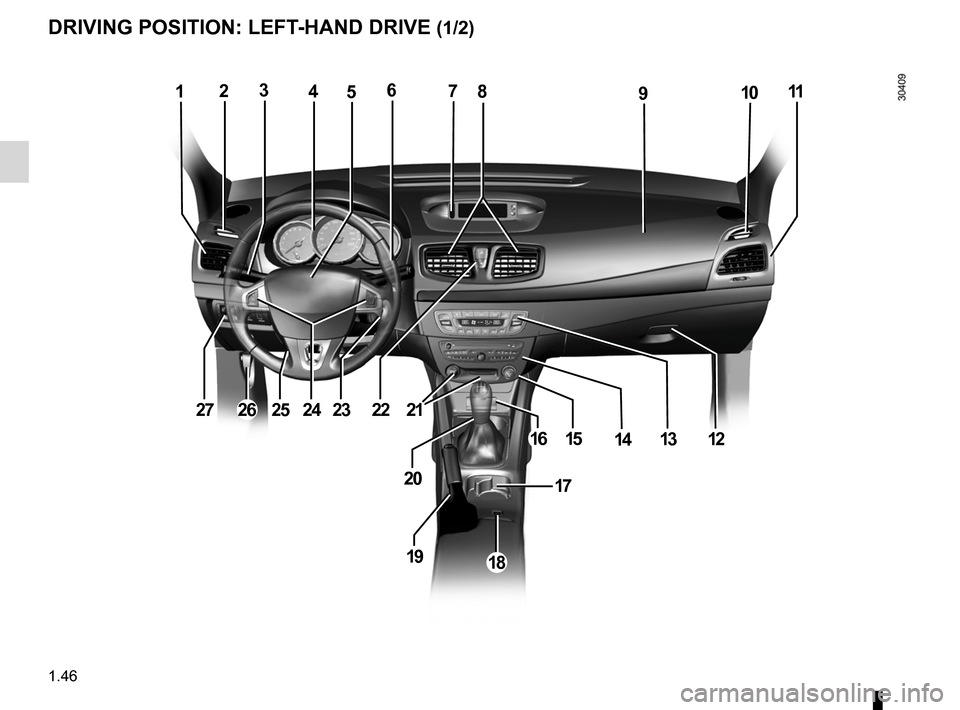
driver’s position .................................... (up to the end of the DU)
controls ................................................. (up to the end of the DU)
dashboard ............................................. (up to the end of the DU)
1.46
ENG_UD13633_1
Poste de conduite direction à gauche (L38 - X38 - Renault)
ENG_NU_891_892-7_L38-B32_Renault_1
Jaune NoirNoir texte
Driving position
DRIVINg pOsITION: LEFT -hAND DRIVE (1/2)
123456891011
12131416
2122
19
15
7
1720
18
2623252427
Page 52 of 241
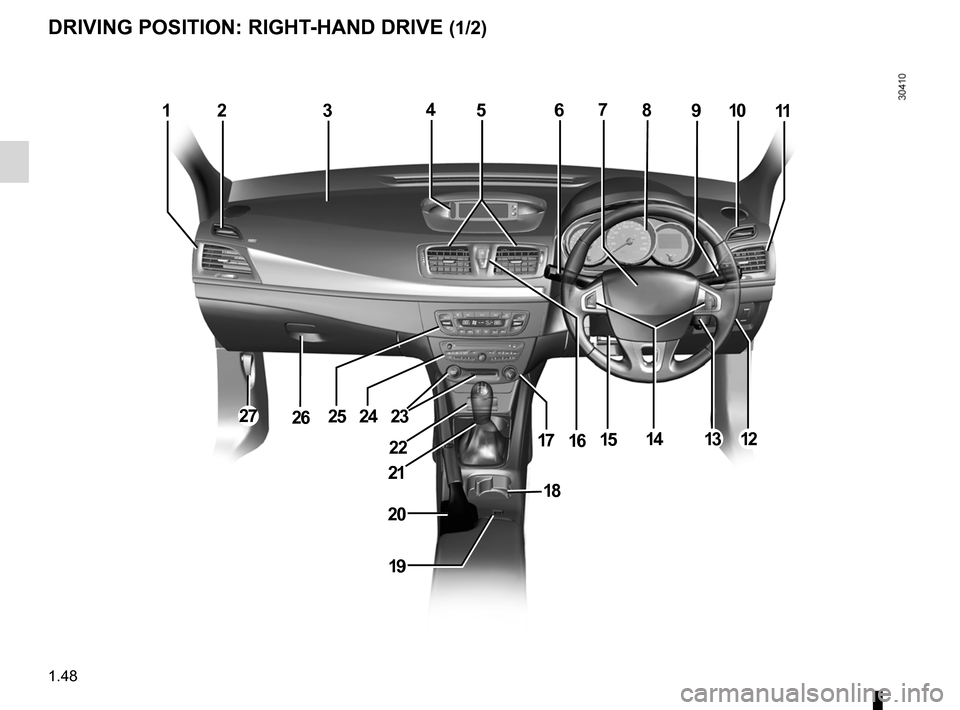
driver’s position .................................... (up to the end of the DU)
controls ................................................. (up to the end of the DU)
dashboard ............................................. (up to the end of the DU)
1.48
ENG_UD13634_1
Poste de conduite direction à droite (L38 - X38 - Renault)
ENG_NU_891_892-7_L38-B32_Renault_1
Jaune NoirNoir texte
DRIVINg pOsITION: RIghT -hAND DRIVE (1/2)
2378
18
11
24
610
161712
27
21
9
26
14
54
15
23
1
22
19
20
13
25
Page 132 of 241
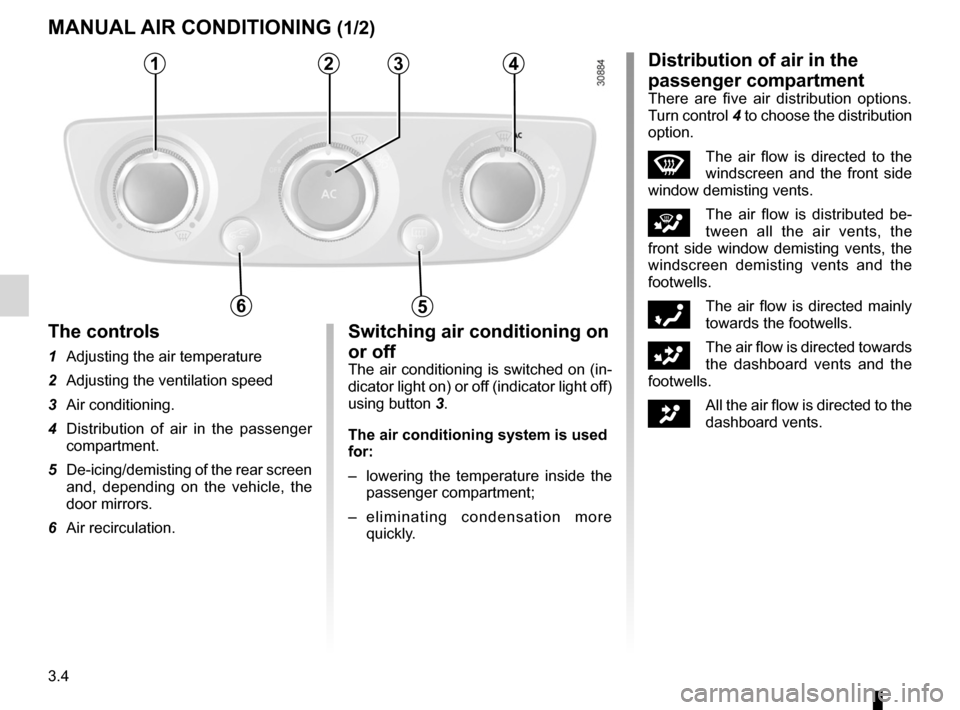
3.4
ENG_UD13665_1
Air conditionné (L38 - X38 - Renault)
ENG_NU_891_892-7_L38-B32_Renault_3
Jaune NoirNoir texte
Manual air conditioning
MANuAl AIR coNDITIoNINg (1/2)
1234
56
The controls
1 Adjusting the air temperature
2 Adjusting the ventilation speed
3 Air conditioning.
4 Distribution of air in the passenger
compartment.
5 De-icing/demisting of the rear screen
and, depending on the vehicle, the
door mirrors.
6 Air recirculation.
Switching air conditioning on
or off
The air conditioning is switched on (in-
dicator light on) or off (indicator light off)
using button 3.
The air conditioning system is used
for:
– lowering the temperature inside the
passenger compartment;
– e l i m i n a t i n g c o n d e n s a t i o n m o r e
quickly.
Distribution of air in the
passenger compartment
There are five air distribution options.
Turn control 4 to choose the distribution
option.
WThe air flow is directed to the
windscreen and the front side
window demisting vents.
iThe air flow is distributed be -
tween all the air vents, the
front side window demisting vents, the
windscreen demisting vents and the
footwells.
óThe air flow is directed mainly
towards the footwells.
GThe air flow is directed towards
the dashboard vents and the
footwells.
JAll the air flow is directed to the
dashboard vents.
Page 137 of 241
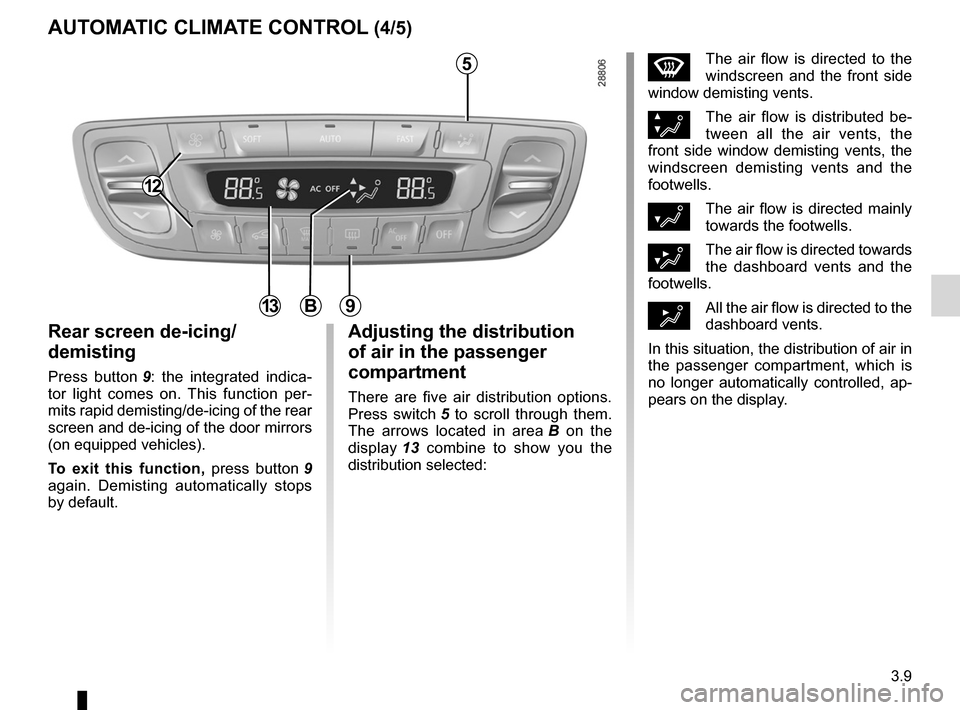
rear screen de-icing/demisting .............................. (current page)
windscreen de-icing/demisting .............................. (current page)
JauneNoirNoir texte
3.9
ENG_UD14525_3
Air conditionné automatique (X95 - B95 - D95 - L38 - X38 - X32 - B32\
- Renault)
ENG_NU_891_892-7_L38-B32_Renault_3
AuT oMATIc clIMATE coNTRol (4/5)
Rear screen de-icing/
demisting
Press button 9 : the integrated indica -
tor light comes on. This function per -
mits rapid demisting/de-icing of the rear
screen and de-icing of the door mirrors
(on equipped vehicles).
To exit this function, press button 9
again. Demisting automatically stops
by default.
12
WThe air flow is directed to the
windscreen and the front side
window demisting vents.
×The air flow is distributed be -
tween all the air vents, the
front side window demisting vents, the
windscreen demisting vents and the
footwells.
¿The air flow is directed mainly
towards the footwells.
¾The air flow is directed towards
the dashboard vents and the
footwells.
½All the air flow is directed to the
dashboard vents.
In this situation, the distribution of air in
the passenger compartment, which is
no longer automatically controlled, ap -
pears on the display.9
Adjusting the distribution
of air in the passenger
compartment
There are five air distribution options.
Press switch 5 to scroll through them.
The arrows located in area B on the
display 13 combine to show you the
distribution selected:
5
B13
Page 158 of 241
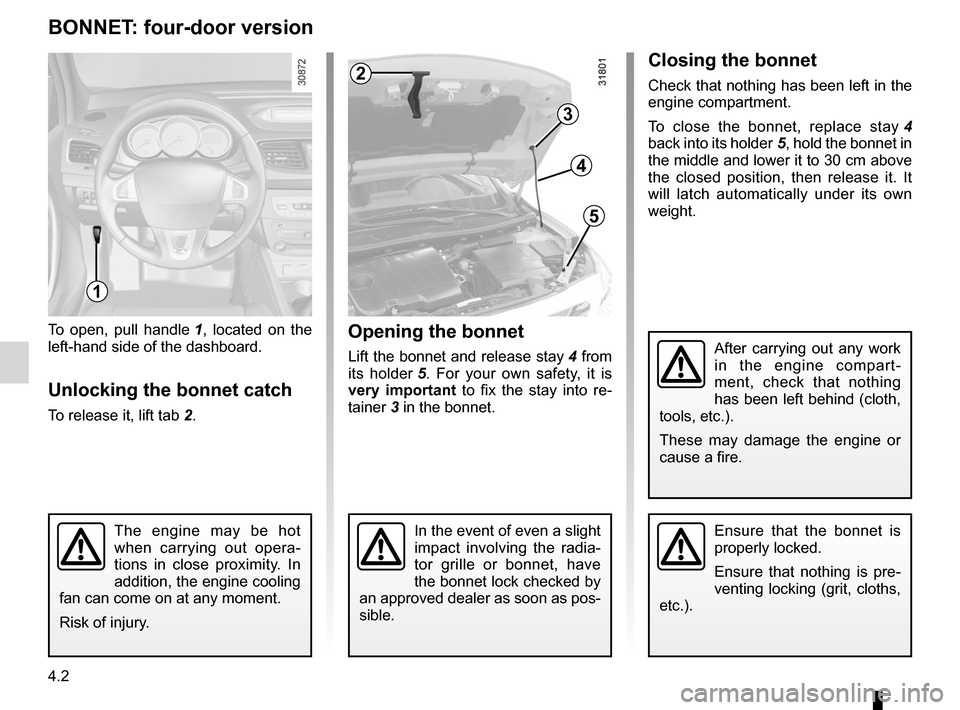
bonnet................................................... (up to the end of the DU)
maintenance: mechanical ...................................... (up to the end of the DU)
4.2
ENG_UD23759_3
Capot moteur (L38 - X38 - Renault)
ENG_NU_891_892-7_L38-B32_Renault_4
Jaune NoirNoir texte
Bonnet
Opening the bonnet
Lift the bonnet and release stay 4 from
its holder 5 . For your own safety, it is
very important to fix the stay into re -
tainer 3 in the bonnet.
To open, pull handle
1 , located on the
left-hand side of the dashboard.
Unlocking the bonnet catch
To release it, lift tab 2.
BOnnet: four-door version
1
2Closing the bonnet
Check that nothing has been left in the
engine compartment.
To close the bonnet, replace stay 4
back into its holder 5, hold the bonnet in
the middle and lower it to 30 cm above
the closed position, then release it. It
will latch automatically under its own
weight.
Ensure that the bonnet is
properly locked.
Ensure that nothing is pre -
venting locking (grit, cloths,
etc.).The engine may be hot
when carrying out opera -
tions in close proximity. In
addition, the engine cooling
fan can come on at any moment.
Risk of injury.In the event of even a slight
impact involving the radia -
tor grille or bonnet, have
the bonnet lock checked by
an approved dealer as soon as pos-
sible.
3
4
5
After carrying out any work
in the engine compart -
ment, check that nothing
has been left behind (cloth,
tools, etc.).
These may damage the engine or
cause a fire.